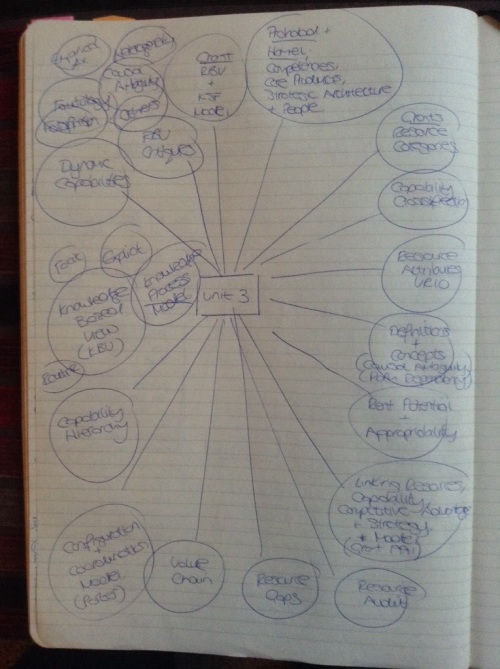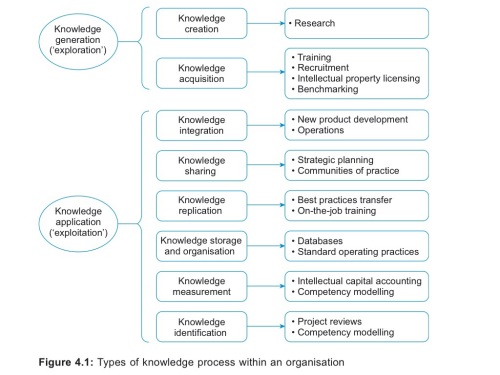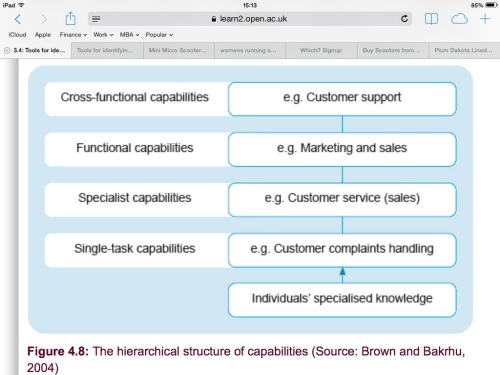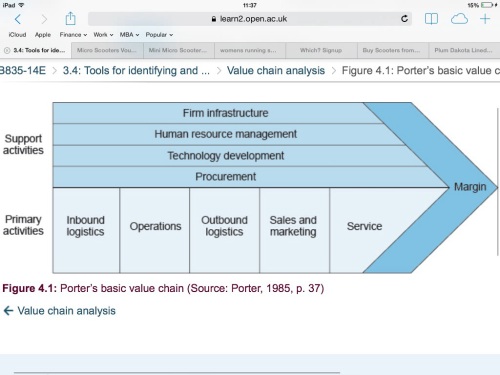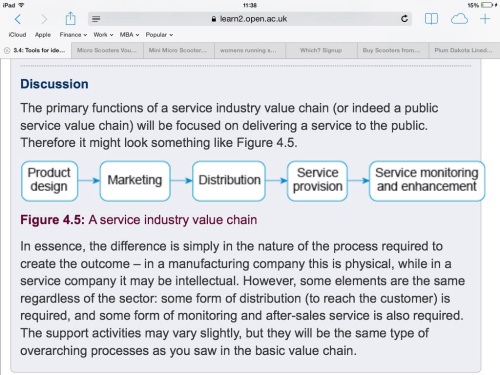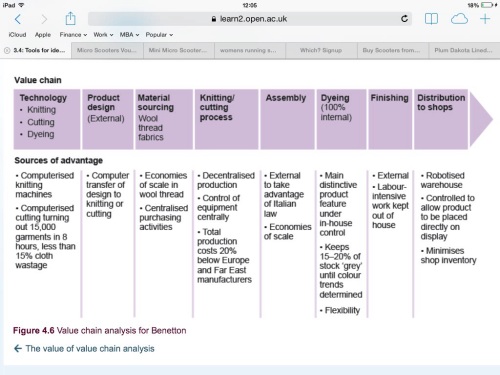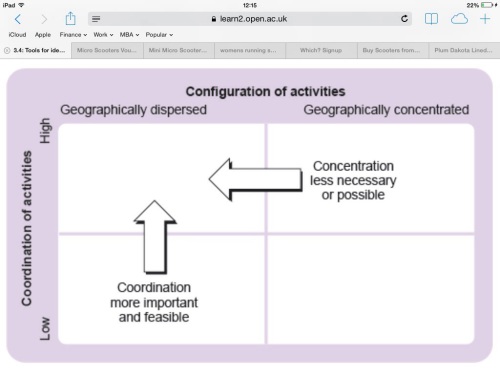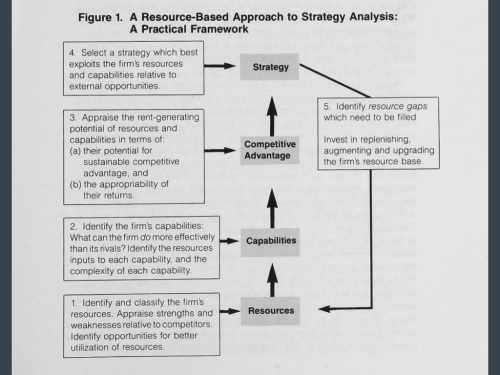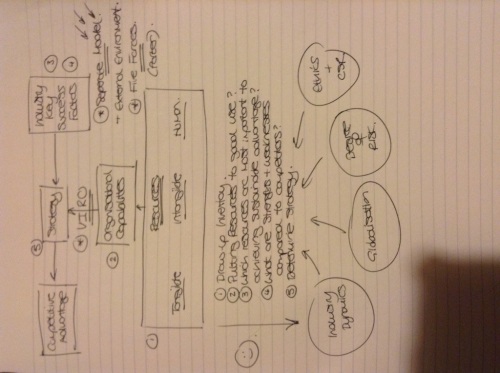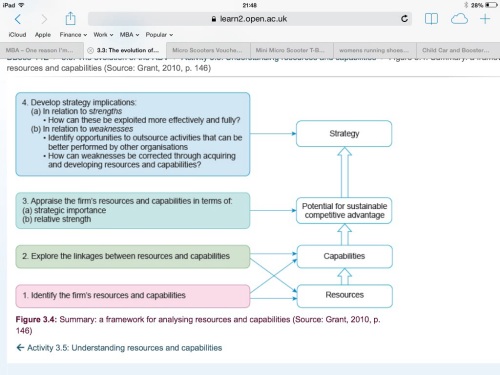Tag Archives: RBV
RBV Critiques…
Tautology – circular reasoning? Stating the same thing twice?
Empirical assessment is difficult. As most value seems to lie with capabilities relating to organisational learning, yet these capabilities and resources are difficult to measure/quantify. Studies focus on the measurable, because they are measurable, not necessarily because they are the most important.
Firm Heterogeneity means that apples can’t be compared to apples, and so the value of inferences is reduced.
Causal ambiguity and large complex firms mean that it’s difficult to isolate the resources that have specifically contributed to competitive advantage. How can you measure something that the firm can’t out its finger on in the first place? Or that due to events over time are so difficult to pin down? Of competitors can’t tie it down how can studies?
Other factors are not taken into account. How can a study in resources and advantage take account of anything else that may have contributed to that advantage?
It’s largely a falsification issues. The claims can’t be proven nor disproven!
Filed under Strategy
Dynamic Capabilities
Those capabilities that are concerned with reorganising resources within highly dynamic markets in order to maintain competitive advantage. See Eisenhardt and Martin (2000) as an example.
I would suggest that they differ from regular capabilities in that they are not capabilities that result from grouping resource, but are an antecedent to grouping resources to achieve capabilities. Probably not a great description there! The processes that create processes.
They enable a firm to respond dynamically to changing environments, in order to maintain or gain competitive advantage through reconfiguration.
E.g – product development, strategic decision making and alliancing….
Not convinced I understand this concept at all!??!?!
Filed under Strategy
Further Developments of the RBV – The Knowledge Based View…
Grant (1996): If knowledge is the critical resource, and people own the knowledge, then employees own the bulk of resources.
This links back to my post a while ago here.
Robert Grant – West Country legend 🙂 – discusses the British National Health service NHS and how reforms have quite often made matters worse. A regular newspaper headline topic. He suggests that knowledge of how the present system works is critical and that when reforming, often knowledge is lost through employee redundancies/cuts and key understanding and information is lost that would have otherwise helped improved the organisation. Managing knowledge is critical.
Extract from Grant (2010) …
Types of Knowledge…
Tacit knowledge is the know how.
Explicit knowledge is the know about.
The paradox is that in order to utilise knowledge we need to replicate it. Tacit knowledge tends to be the most valuable for creating competitive advantage. Trouble is it isn’t easily transferable. So in order to transfer it it has to be made explicit – and in doing so you make it easy to replicate/imitate, and make it easier for competitors to negate any advantage gained.
Knowledge can be exploited in a few ways. Explicit knowledge is passed through standard operating procedures, inductions, formal training…..Tacit knowledge can be passed via apprenticeships and on-the-job training, informal networks may also prove to be valuable in passing tacit knowledge.
Having recently started at my new organisation I have seen knowledge passed explicitly in the form of induction and it’s key documents to read, the familiarisation of the site, the department ICT filing structure….the obvious explicit knowledge example are all of the lesson plans for delivery and the powerpoint presentations that go with them.
Examples of tactic knowledge include having to organise a graduation ceremony and dinner, where daily – if not hourly – I would find out additional information. Some of the things associated with graduation were not laid out explicitly and it made things very difficult when new information came at short notice.
Routine has a strong part to play in the passage of knowledge. Particularly tacit knowledge. Formula 1 racing teams, Huff House builders…. All provide examples of how an organisational routine allows passage of tacit knowledge even when those with the original knowledge move on, and those without it join. However, it is argued that yes the knowledge is retained but the that perhaps the application of it is lost.
The sharing of information is really key in my environment. People move roles every two to three years and that is a real threat to strategy implementation – so tying down that tacit knowledge somehow and passing it on would be of great benefit. The trouble is these changeovers are often done without any face to face handover, or if there is that opportunity the time available is limited or by the time the new incumbent gets into role the environment had changed.
Filed under Strategy
Protected: My Own Organisations Capabilities in Relation to the Capability Hierarchy…
Enter your password to view comments.
Filed under Strategy
Capabilities – Apple, Samsung, Smartphones and some Double Loop Learning….
Listened to a really interesting recorded discussion today with Robert Grant (of KSF/RBV Strategy fame – and of course English West Country Fame (judging by his accent).
The discussion was about capabilities within organisations embedded in the smart phone market. It highlights how Apple don’t actually manufacture anything – they outsource that – and how consequently manufacturing capability may not really be key to competitive advantage for these phones.
There’s been some pretty tough legal battles between Apple and Samsung recently, particularly over breech of Patents relating to hthe operating systems of these phones. Apple accusing Samsung that is. So it appears that external legal issues and incumbent behaviours to project operating system capabilities, create a fierce amount of rivalry – and so it may be that an operating system competency is where the value lies.
Interestingly the discussion went on to highlight increasing use of the android operating system, which is open source (available to all). Now first of all I thought –
well that’s no good is it, because if it isn’t rare then it won’t be able to create the best opportunity for competitive advantage
. But the discussion went on to highlight that this may turn in to a problem for apple – as the ability for everyone to develop operating systems for smartphones is a huge substitute for apple products, and so it may have been naive of me to jump into my evaluation of that particular issue.
A very interesting insight to capabilities and how they can be considered. I still think the value of hierarchical lists here is limited – there’s no way all possible capabilities can be listed to cater for all industries, and what I see as a capability may be different to someone else’s opinion. But it has helped me to remember to always go to that next stage when formulating an opinion.
I value the ability to NAIL an issue and if I jump straight in I won’t be able to do that. It may have been ok with somethings up to now, but thinking, learning and situations in and out of work are getting more complex the older i get and I should change with them.
What I need to do is ensure that I don’t stop at the first stage when assessing something – but to always go a little further before jumping in.
A Hierarchy of a Capabilities….
A Higher level of capability = higher level of competitive advantage.
However, higher levels of capability generally come with higher levels of complexity and coordination!
There is a consideration of broadly defined capabilities and more focused definitions. For example cardiac care capabilityin a hospital is the result of a number of other, finite, capabilities; diagnosis, treatment, surgery, post-op care…… Toyota is another example where; manufacturing, assembly, supply chain management, scheduling, quality control capabilities merge to create the Lean capability.
Typically, cross-functional capabilities sit at the top of the capability hierarchy – but as mentioned these are often complex and difficult to coordinate/maintain. New Product Development is Typically seen as a high level Capability.
Filed under Strategy
Tools for identifying and evaluating resources (2)….
The Value Chain…
And so I’m back to year 1 Operations Module and Porters Value Chain. Only this time it’s not about looking at where to improve operations it’s through a more strategic lens.
So this time around its about What areas add value (better rents), what areas need to be improved? perhaps by Outsourcing or bringing under central control.
Of course comparing your performance to Competitors is important here. Zara the clothing manufacturer were able to compete with Benetton by maintaining central control of their garment design process (Benetton Outsource this) – this gave them a time to market advantage.
Using a value chain helps focus on what you do well and where we can improve matters. And of course not all value chains will look the same; public sector and NFP’s will no doubt have some ‘service’ provision aspects rather than a manufacturing one.
Configuration and Coordination…
The configuration and coordination of a firms value chain gives good insight and allows surfacing of opportunities and threats. Café Direct (the fair trade coffee firm) for example – have a global value chain that relies on coffee bean growers across the globe, cooperatives in the same countries, distributors across a number of countries and retailers in various locations with differing stock keeping arrangements and distribution channels. The chain is configured in order to offer less fortunate farmers the opportunity to support their families in poor economic countries, and to help them develop their capabilities and regional infrastructure alike. In order to get them the best deal Café Direct market and sell their products to better economically positions countries and markets, to maximise returns. It’s clearly seeking to take advantage of ethical trends and consumer beliefs, whilst sourcing a cheaper product from emerging economies. I’ll add though, not seeking this for its own benefit but aiming to maximise returns for the bean growers. It’s working hard on marketing and mass retail channels too – rebranding its products to target niches and trying to improve sales through large superstore outlets. The latter may have affected sales for the worst however by conflicting with core values. Coordinating grower supply with consumer demand and making sure shelves are stoked to meet Requirements will be difficult. The product has to travel a long way and substitutes that are closer will be extremely rare!
This final model comes from Porter too…
It shows the relationship between concentration and coordination. For example – if activities don’t have to be concentrated then a highly coordinated and global approach might offer benefits. You’ll see from the model that other configurations are possible, and that these will be dependant on product type, location……
Filed under Strategy
Tools for identifying and evaluating resources (1)….
The Resource Audit…
More of a formal term than a framework It seems. Reading Grant’s 1991 paper highlights the fundamentals of the RBV and the importance of linking, resources, to capabilities to competitive advantage and ultimately profit.
The categorisation of capabilities is an important tool that I missed in my previous post about my assignment, although I was able to pick up on the important aspect of comparing them to competitors in order to formulate your strategy. However, having completed an extensive review of my organisations industry, value net, key success factors, VRIO resources and capabilities and uncovered a strategic approach I can see that sometimes not all capabilities fit into categories suggested in a framework. For example; we are very too at imparting specialist knowledge to students – which doesn’t appear in a Grants framework specifically.
I’ve had trouble taking the RBV and some of Grants comments as gospel, especially when compared to Porters IO view of strategy. Although I like the idea of an internal view, since starting these readings I’ve always thought that the external (Porters) approach was still really important. There are times when Grant criticises Porter, but then highlights the importance of the external environment in his model. Grant does argue that industry attractiveness shouldn’t drive your strategy choices, and I can see that your current capabilities would support that, but why not do as he says and augment your resources to take opportunities in a newly found attractive industry????
Anyway, two key terms I’ve learnt from this reading: Filling Resource gaps and Developing a resource base.
Anyway, onward to reading about application of the value chain for consideration of strategy…..
Filed under Strategy
Linking Resources, Capability, Key Success Factors and Competitive Advantage….
And so we are back to my first post about the RBV and looking inside the organisation in order to develop strategy Unit 3 – The RBV
Through this stage of learning I’ve had the next assignment in the back of my mind, and as a result of the separate frameworks we’ve been taught I have been trying to make my own – as I’ve seen the benefits of each of them for the assignment along the way. I took all these frameworks and tried to link them together in the hope that I would have a logical approach to my essay. Below you’ll be able to compare my version with one that we were presented with by the course right at the end here.
So what…. At first I thought it was frustrating and asked ‘why didn’t we get that at the start’ but I’m glad now that I have been able to experience things in isolation before putting them together. It’s the ‘whole-part-whole’ approach to learning. I understand the end product much better now, so I’m almost happy to approach the assignment with some confidence.
I’ll keep this step by step approach close to hand and try to put it into practice before the assignment is due a few times. I’ve learnt that by doing that in my own time I can be better placed to critically analyse its use and back it up with practical evidence.
Ps: can anyone guess that we are looking at buying a scooter for the boy, new running shoes for the wife and a new car seat too? 🙂
Filed under Strategy

